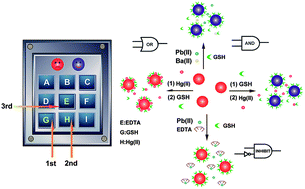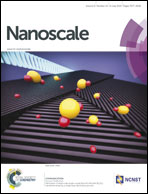Glutathione-facilitated design and fabrication of gold nanoparticle-based logic gates and keypad lock†
Abstract
In this paper, we describe how we developed a simple design and fabrication method for logic gates and a device by using a commercially available tripeptide, namely glutathione (GSH), together with metal ions and disodium ethylenediaminetetraacetate (EDTA) to control the dispersion and aggregation of gold nanoparticles (NPs). With the fast adsorption of GSH on gold NPs and the strong coordination of GSH with metal ions, the addition of GSH and Pb2+ ions immediately resulted in the aggregation of gold NPs, giving rise to an AND function. Either Pb2+ or Ba2+ ions induced the aggregation of gold NPs in the presence of GSH, supporting an OR gate. Based on the fact that EDTA has a strong capacity to bind metal ions, thus preventing the aggregation of gold NPs, an INHIBIT gate was also fabricated. More interestingly, we found that the addition sequence of GSH and Hg2+ ions influenced the aggregation of gold NPs in a controlled manner, which was used to design a sequential logic gate and a three-input keypad lock for potential use in information security. The GSH strategy addresses concerns of low cost, simple fabrication, versatile design and easy operation, and offers a promising platform for the development of functional logic systems.


 Please wait while we load your content...
Please wait while we load your content...